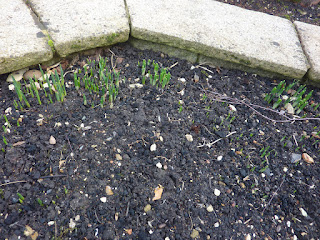At the darkest time of the year, it's good to look back on garden in summer. But before that I looked at what I said this time last year. Well, no snow, like that which fell the previous December and not the exceptionally mild weather of the year before. So fairly boring, mostly cloudy and windy with spells of rain. One of the wettest autumns I can remember. Good for the garden.
Three holidays this year: Ingleton in May, Bakewell in July and Wells-next-the-Sea in October. It may look like a boring stretch of coastal path, but this walk on the last day out of Wells was quiet and beautiful.
Lots of walking from home this year as too many posts on this blog will demonstrate. But finding some circular routes across fields and along the canal suit me as they are all flat. As is the walk from the car park at Wilstone Reservoir up to another branch of the canal and along to the church of St Mary the Virgin at Drayton Beauchamp. My pole comes in handy in Wendover Woods and other walks in the hills. About six or seven miles is enough for me these days. Visits to some National Trust properties are the same as previous years.
Four trips to the theatre this year: The Tempest at the RSC in Stratford with Alex Kingston was a revelation, The Pillowman at The Duke of York's and Hamnet at The Swan Theatre at RSC Stratford came in June with Cuckoo at the Royal Court in August. I used my book on London Theatres to compile a list of all the plays I had seen. Published on this blog on 5th May. My favourite films this year have been A Good Person, Air, Cairo Conspiracy, Polite Society, (Not forgetting one major highlight, the song over the end credits - "Identity" by X-ray Spex), Oppenheimer, Past Lives and Anatomy of a Fall. A few visits to the Rex Cinema in Berkhamsted for some excellent foreign films. Finding Sight and Sound magazine (see post 18th December) has been a revelation. My post of 24th October says everything about my continuing film studies.
My favourite books this year have been Ann Patchett's These Precious Days, Small Things Like These by Claire Keegan and two by Susie Boyt, The Last Hope of Girls and Loved and Missed. I attended my last meeting of Tring Book Club in August. My post of 13th of that month shows that we read 147 books in thirteen years. I think I only made one visit to London, to Battersea Power Station in August and a trip up Lift 109. We terminated our contract with Sky in June, saving ourselves £39 per month with BT's Big Sport. We did lose the odd Sky channel that we hardly watched, but gained BT Sport in HD. As for TV, our favourite programme Ghosts came to an end. The final series of the six was excellent, as was the Christmas Special.
There was little new in the garden, except I followed Monty Don's advice on Gardener's World and grew some cosmos from seed, sowed in compost in the conservatory.
When planted out, the result was disappointment in pots, but fine in the borders.
Like last year, I went for bedding dahlias in main border. Ended up being too overcrowded, so I don't need to buy so many next year.














































.jpg)

.jpg)
.jpg)
.jpg)

.jpg)



.jpg)

